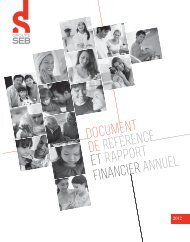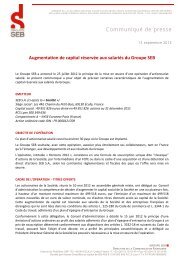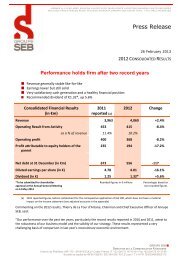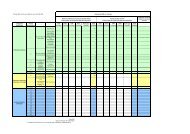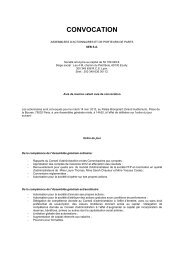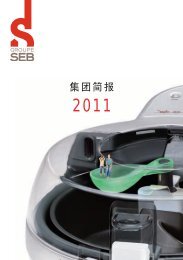Financial Report and Registration Document 2010 - Groupe Seb
Financial Report and Registration Document 2010 - Groupe Seb
Financial Report and Registration Document 2010 - Groupe Seb
You also want an ePaper? Increase the reach of your titles
YUMPU automatically turns print PDFs into web optimized ePapers that Google loves.
1<br />
GROUPE SEB IN <strong>2010</strong><br />
MANAGEMENT REPORT ON <strong>2010</strong><br />
MANAGEMENT REPORT ON <strong>2010</strong><br />
Information on risk management, social performance <strong>and</strong> the environment is presented in the following sections.<br />
1<br />
<strong>2010</strong> HIGHLIGHTS<br />
GENERAL ENVIRONMENT<br />
After 2009, with its host of negative factors, <strong>Groupe</strong> SEB enjoyed a<br />
much more favourable environment for its business in <strong>2010</strong>, with a good<br />
consumption level maintained throughout Western European countries <strong>and</strong><br />
recovering dem<strong>and</strong> in the number of emerging markets severely affected<br />
by the 2009 crisis. Nevertheless, the situation is highly uncertain in some<br />
countries – especially in Europe – where economies have become very<br />
fragile <strong>and</strong> are currently going through austerity measures that are potentially<br />
bad for consumption. In this buoyant context, despite a few glitches, the<br />
Small Household Equipment sector confirmed its strength, driven by good<br />
consumer dem<strong>and</strong> in the majority of mature markets <strong>and</strong> by the significant<br />
recovery of most developing markets. However, the crisis has left traces in<br />
the buying behaviour of consumers in these countries which was manifested<br />
through a greater tendency towards low-cost products <strong>and</strong> special offers.<br />
Meanwhile, the monetary environment has remained volatile, but compared<br />
to the atypical 2009, where virtually all currencies collapsed against the euro,<br />
ultimately, the general trend for the financial year was the appreciation of<br />
those very currencies against the euro. However, there was a great deal of<br />
tension on commodities <strong>and</strong> on the price of oil, which increased significantly.<br />
With respect to retail distribution, the financial difficulties encountered in<br />
2009 by many retail banners due to the downturn in consumption <strong>and</strong> the<br />
credit crunch abated over the year. This gradual normalisation of the situation<br />
has helped to restore credit insurance levels more in tune with the “pre-crisis”<br />
levels, depending on the country. The <strong>2010</strong> financial year unfolded without<br />
any accidents <strong>and</strong> without customer defaults, but in a context of cautious<br />
re-stocking rather than real reconstitution of inventories.<br />
CURRENCIES<br />
After two financial years marked by a negative currency effect on<br />
sales (-€69 million in 2008 <strong>and</strong> -€63 million in 2009), <strong>2010</strong> marks a genuine<br />
break with an impact of exchange rates of +€171 million on turnover, primarily<br />
recorded in the second half. In fact, practically all the Group’s operating<br />
currencies contributed to this positive effect, but four of them were decisive:<br />
the real, yuan, dollar <strong>and</strong> rouble. These four alone account for nearly 65% of<br />
the total impact. The remaining 35% comprise 20 or more currencies which<br />
had a more modest impact.<br />
All our major operating currencies, based on average exchange rates,<br />
appreciated against the euro in <strong>2010</strong>:<br />
dollar: +5.1% over the year due to a weakening early in the year, followed<br />
by a second half where it firmed up;<br />
yuan: +6.1% over the year, down in the first quarter <strong>and</strong> up later, as for<br />
the dollar;<br />
real: +18.8% over the year, with a slowdown in appreciation in the<br />
fourth quarter;<br />
rouble: +9.6% over the year, with a more modest fourth quarter;<br />
the yen, won, Turkish lira, zloty, Mexican peso all appreciated significantly<br />
against the euro, between 8 <strong>and</strong> 16%.<br />
The persistent volatility is likely to disrupt the Group’s very international<br />
trading activity whose priority remains the preservation of local profitability.<br />
RAW MATERIALS<br />
The Group’s business is exposed to fluctuations in the price of certain raw<br />
materials, including metals such as aluminium, nickel (used in stainless steel)<br />
<strong>and</strong> copper. The latter peaked in 2007 <strong>and</strong> early 2008, before turning around<br />
sharply with a trough in late 2008, early 2009. Since then, we have seen a<br />
gradual, then more significant but steady increase in the price of metals.<br />
Rallying markets, especially Chinese domestic dem<strong>and</strong>, caused strong<br />
tensions on commodities, aggravated by the systematic failure to reopen<br />
production capacities which had been temporarily shut down during the<br />
crisis. The combination of these two phenomena resulted in tense markets,<br />
frequent inventory shortages <strong>and</strong> increasing prices.<br />
For <strong>2010</strong> as a whole, aluminium prices shot up by 30% with an average<br />
price of USD 2,173 per tonne. In practice, the Group mostly buys aluminium<br />
for which all the price components – metal LME price, access bonus <strong>and</strong><br />
value added – increased considerably in <strong>2010</strong>. Nickel prices jumped by<br />
43% reaching an average price of USD 21,000 per tonne in <strong>2010</strong>, versus<br />
USD 14,700 per tonne in 2009. Copper continued to be characterized by<br />
major volatility but, despite temporary contraction in Spring <strong>2010</strong>, remained<br />
generally in a signifi cant infl ationary spiral with, fi nally, an average <strong>2010</strong><br />
price of USD 7,500 a tonne, up by 47% compared to 2009. This very sharp,<br />
upward trend on metals (which continued in <strong>2010</strong> with copper, reaching<br />
record highs early in the year) in the end had limited impact on business <strong>and</strong><br />
on our performance in <strong>2010</strong>, a fact particularly due to the Group’s hedging<br />
policy for part of its metal requirements.<br />
GROUPE SEB<br />
FINANCIAL REPORT AND REGISTRATION DOCUMENT <strong>2010</strong><br />
11



